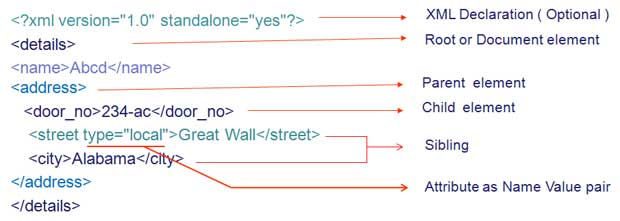PHP & XML : Extensible Markup Language
In XML, data is presented as a series of nested elements, each represented by a pair of tags. These tags define the beginning and end of an element, and elements can contain attributes and data content. The structure of XML documents is hierarchical, resembling a tree-like structure.

PHP XML Functions
| SimpleXMLElement | Name of the XML tag from the object |
| getName | Name of the XML tag from the object |
| children() | child node details |
| count() | Counting number of Children of an XML element |
| addChild() | Adding Child element to element of XML object |
| asXML | Getting string output or writing to file |
| addAttribute() | Adding attribute to element of XML object |
| getNamespaces() | Getting NameSpaces from XML object |
| simplexml_load_file() | creating object by reading from XML file |
Application of XML files
| dropdown list | Create dropdown list box by using data from XML file |
| File from Database | Creating XML file by using records from MySQL table |
| RSS feed | Generating RSS feed by using Link and descriptions of webpages |
Sample XML files
| file-xml-demo.xml | Sample XML file |
| xml-sample1.php | Creating XML string by PHP |
| php-xml-loadstring.php | Creating XML string with name space by PHP |
| xml-sample3.xml | With attributes having name & value |
XML is commonly used for various purposes:
- Data Exchange: XML is often used to structure and exchange data between different systems, applications, or platforms. It acts as a standardized format that different software can understand.
- Configuration Files: Many software applications use XML files to store configuration settings. This allows users to modify application behavior without directly editing code.
- Web Services: XML is a key component of many web service technologies such as SOAP (Simple Object Access Protocol) and REST (Representational State Transfer) for sending and receiving data between distributed systems.
- Document Formats: Some document formats, like Microsoft Office's older formats (.docx, .xlsx, .pptx), are based on XML. This allows for better compatibility and programmatically manipulating document content.
- RDF and Semantic Web: XML is used in the Resource Description Framework (RDF) to describe resources on the internet, enabling the Semantic Web and linking related data.
- Configuration of Hardware Devices: Some hardware devices can be configured using XML-based files to define settings and parameters.
- Data Storage: XML can be used as a data storage format for small to medium-sized datasets, although it's not as efficient as dedicated database systems.
PHP
Subscribe to our YouTube Channel here
This article is written by plus2net.com team.
https://www.plus2net.com

